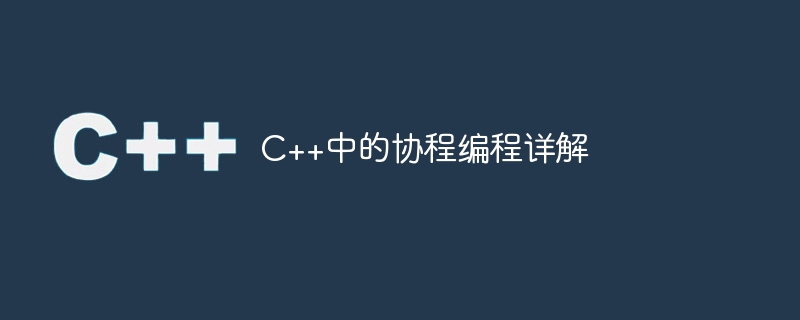

With the continuous development of computer technology, programming methods are also constantly innovating and improving. Among them, coroutines Programming is regarded as a relatively new programming method. Coroutine programming was first proposed in 1958 by Melvin Conway in his paper. But it is the C language that truly promotes and applies coroutine programming. Therefore, this article will analyze and explain coroutine programming in detail from the perspective of C language.
What is a coroutine?
Before explaining coroutine programming, we need to first understand what coroutine is. Coroutines can be simply understood as a special sub-function that can be suspended when execution reaches a specific point and wait for re-awakening before continuing execution. Compared with traditional function calls, the execution method of coroutines is more flexible.
The suspension and wake-up of the coroutine can be controlled by itself, not by the caller. The advantage of this is that when the coroutine performs some long-term operations, it can give up CPU resources and let other tasks be performed, thereby making better use of computer resources.
In C, coroutines can be implemented by using the keyword co_await, which allows a coroutine to suspend when executing to a certain point and reawaken after reaching pre-set conditions. .
How to use coroutines?
In C, using coroutines requires the help of a coroutine library. Currently, the most commonly used coroutine libraries are Boost.Coroutine and the coroutine library that comes with C 20. Let's take the coroutine in C 20 as an example to explain how to use coroutine.
In C 20, we can use the co_await keyword and co_yield keyword to define the coroutine function. co_await means to suspend the current coroutine and wait to be awakened, while co_yield means to suspend the current coroutine and return some values or status when the coroutine function reaches a certain point. The following is a simple example of a coroutine function:
#include#include using namespace std; struct HelloWorld { struct promise_type { HelloWorld get_return_object() { return {}; } std::suspend_never initial_suspend() { return {}; } std::suspend_never final_suspend() noexcept { return {}; } void unhandled_exception() {} }; HelloWorld() {}; void print() { cout << "Hello, world!" << endl; } void operator()() {} }; int main() { HelloWorld hello_world; hello_world(); hello_world.print(); return 0; }
In the above example, we define a structure named HelloWorld, which is a coroutine function. In this structure, we implement a nested structure called promise_type, which controls the behavior of the coroutine function. We also define a member function called print, which prints the "Hello, world!" string.
In C 20, we can use the coroutine_handle class to control the execution status of the coroutine. Before calling the coroutine function, we need to obtain a coroutine_handle object. After the coroutine function is executed, we need to manually release the object. The example is as follows:
int main() { HelloWorld hello_world; auto handle = hello_world(); handle.resume(); hello_world.print(); handle.destroy(); return 0; }
In the above example, we first obtain a coroutine_handle object, and then call its resume() function, which will execute the code in the coroutine function until the co_await or co_yield key is encountered word, the current coroutine will be suspended. Finally, we manually call the destroy() function to release the coroutine.
In the coroutine function, we can suspend the coroutine through the co_await and co_yield keywords. The following is an example:
#include#include using namespace std; struct Generator { struct promise_type { int current_value; std::suspend_always yield_value(int value) { current_value = value; return {}; } std::suspend_never initial_suspend() { return {}; } std::suspend_never final_suspend() noexcept { return {}; } Generator get_return_object() { return Generator(coroutine_handle ::from_promise(*this)); } void unhandled_exception() {} }; Generator(coroutine_handle h) : coro(h) {} coroutine_handle coro; bool next() { coro.resume(); return not coro.done(); } int value() { return coro.promise().current_value; } ~Generator() { coro.destroy(); } }; Generator fibonacci(int to) { int a = 0, b = 1; while (a <= to) { co_yield a; auto tmp = a + b; a = b; b = tmp; } } int main() { Generator gen = fibonacci(10); while (gen.next()) { cout << gen.value() << " "; } return 0; }
In the above example, we define a structure named Generator, which is also a coroutine function. We define a while loop in the coroutine function. Each time the co_yield keyword is executed, the current a value is returned to the caller and the values of a and b are updated. In the main function, we get a Generator object by calling the Generator function, and then continuously call its next() function to get the result returned by the coroutine function.
Summary
Through the above examples, we can see that coroutine programming can make the program more efficient and flexible. In real life, coroutine programming is widely used in various concurrent programming scenarios, such as network programming, multi-thread programming, etc.
In C, with the help of the coroutine library, we can implement coroutine programming more simply and efficiently. In the future, with the development of computer technology and the continuous improvement of C standards, coroutine programming will be applied and promoted in more situations.
The above is the detailed content of Detailed explanation of coroutine programming in C++. For more information, please follow other related articles on the PHP Chinese website!
 What are the differences between c++ and c language
What are the differences between c++ and c language Recommended learning order for c++ and python
Recommended learning order for c++ and python Cost-effectiveness analysis of learning python and c++
Cost-effectiveness analysis of learning python and c++ Is c language the same as c++?
Is c language the same as c++? Which is better to learn first, c language or c++?
Which is better to learn first, c language or c++? The difference and connection between c language and c++
The difference and connection between c language and c++ C++ software Chinese change tutorial
C++ software Chinese change tutorial Cost-effectiveness analysis of learning python, java and c++
Cost-effectiveness analysis of learning python, java and c++



